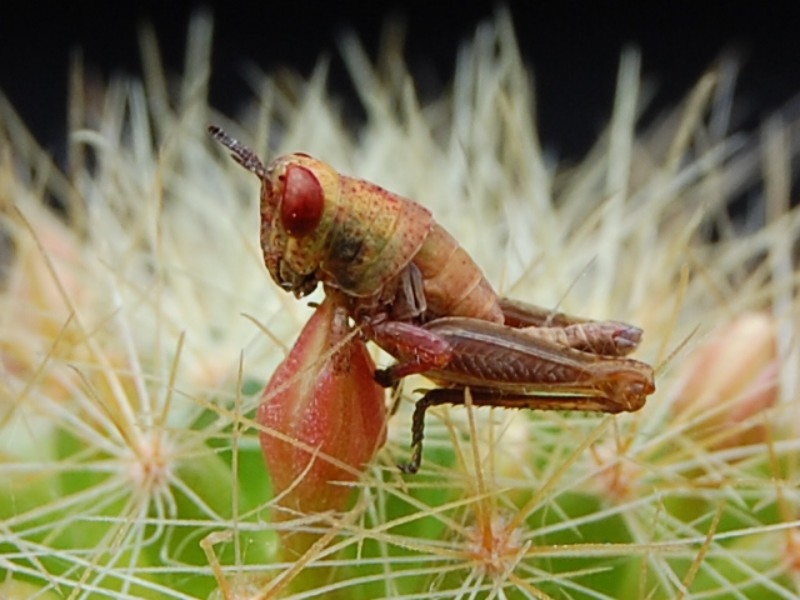Species Novae since The Mammillaria Handbook
No 81 Mammillaria anniana
Original Reference: C.GIass and R.A.Foster, Cactus and Succulent Journal (US.), 53, 79, 1981.
Body: Solitary or cespitose, 15 to 30mm. in diameter, 10-20mm. high, but in cultivation globose, to 50mm. in height and diameter.
Roots: Fibrous
Tubercles: Arranged in 8 and 13 spirals in the larger cultivated specimens but a lower series in smaller, collected specimens, with watery sap, a bright, rich apple-green, paler towards the axils, 4 to 5mm. long (to 7mm. long in cultivated specimens), about 4mm. broad at the base, terete, tapering gradually, then abruptly near the tip.
Axils: With four or five twisted hairs, to 13mm. long, and a tiny tuft of wool.
Areoles: With whitish crinkly wool which appears golden tan to the naked eye through reflected spine colour, about 2mm. in diameter.
Spines: Fine acicular, separable with difficulty into radial and central series; at first erect in tight bundles, then spreading to ascending. Radial spines (13-) 14, 6 to 11mm. long, pale yellowish white, stiff and straight, except, the lowermost ones which may be somewhat twisted, somewhat thickened at the base, radiating almost horizontally.
Central spines 5 to 7 on smaller plants, later 7 to 9 slightly heavier than the radials, yellow to golden amber, darker and considerably thickened at the base (9-) 10 (-12)mm. long, smooth, stiff, straight except for a centrally placed porrect to suberect spine, which is usually hooked, particularly on older cultivated specimens and which, because of its direction, stands out slightly beyond the other spines.
Flowers: 8-12mm. long including the unusually long pericarp, which is up to 5mm. long, beyond which is a distinct and slender "neck", 1.5mm. wide, pale green, not opening widely, to about 6mm. wide.
Perianth segments about 12, pale yellow, about 1mm. wide. Filaments relatively few, tiny, pale, 2.5 to 3mm. long. Anthers tiny, reddish. Style about 5mm. long, very fine. Stigma lobes about 4, relatively long (1 to 1.2mm.), yellowish, spreading, recurved.
Fruit: 2.5 to 3mm in diameter, 10 to 15mm. long, medium cerise, with tiny dried perianth persisting, firmly attached at the axil and when removed axillary hairs adhere to the base of the fruit.
Seeds: Tiny, barely 1mm. long and 0.75mm. wide, more or less globose with a constriction above the relatively large hilum, testa black, pitted.
Type Locality: Cerro Bernal, east of Cuidad Mante, Tamaulipas, Mexico
Distribution: Known only from the type locality.
Holotype: Lau 1332, deposited at the Herbarium of Pomona College, California
Comments: The authors compare M.anniana with M.aurihamata, noting that it differs by its smaller size, higher spine count, more golden less brownish spine colour and its distinctive flowers. With regard to the last named they comment that they are undoubtedly
the smallest in the genus. While this is true if the species is accepted as a member of the Series Stylothelae, or even of the Series Proliferae, which Dr.Hunt regards as a better placement, it is surely not the case for the genus as a whole because those of M.mammillaris are no larger, indeed they are probably smaller.
This species, named for Anni Lau, wife of its discoverer Dr.Alfred B.Lau, is among the less charismatic of the new Mammillaria discoveries during the past two decades. Nevertheless, it is a pleasant plant, which will not outgrow its welcome, and which is less vigourous than most members of the Series Stylothelae and Proliferae.
Mammillaria anniana REP 1806
REP 1806 - Cerro Bernal, 350m - Tamaulipas - Mexico





